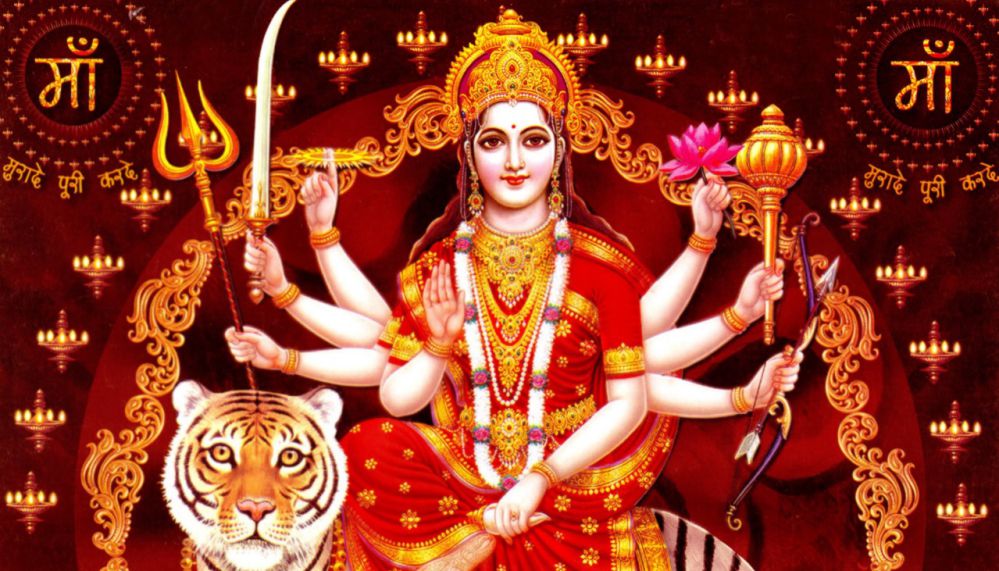No products in the cart.
Navratri is one of the most important festivals for Hindus. There are 5 Navratris is a year for Hindu – Shardiya Navratri, Chaitra Navratri, Ashada Navratri, Pausha Navratri and Magha Navratri. The most important of the 5 Navratris is the Shardiya Navratri and is often called the Maha Navratri. It falls in lunar month Ashwin during Sharad Ritu. The name Shardiya Navratri has been taken from Sharad Ritu. We have listed the basic Navratri Puja Vidhi you could follow during Navratri, the same procedure can be followed for all 5 Navratris.
Navratri Puja Vidhi
For performing the Navratri Puja, you need to wake up early in the morning. Sunrise is considered the best time to perform Navratri Puja. Take bath and wear laundered clothes. Keep the lamp at the left side of the Goddess Durga’s deity. Try to light the ‘Akhand Jyot’. It is advised to have someone at home always if you are lighting the ‘Akhand Jyot’. The scriptures suggest having atleast one person at home. On the right hand side of Goddess Durga’s Idol, keep incense sticks etc. Keep yourself prepared to do the Puja with full devotion and concentration. You are required to keep the kalash and coconut as well. Lay the mat and sit in an upright position in front of the deity. Light the lamp ad blow the ‘Shankh’ invoking Devi.
Ghatasthapana
Ghatasthapana is one of the significant rituals during Navratri and is called the Navaratri Vidhi. It marks the beginning of nine days festivity. Our scriptures have well defined rules and guidelines to perform Ghatasthapana during a certain period of time at the beginning of Navratri. Ghatasthapana is invocation of Goddess Shakti and doing it wrong at time, as our scriptures forewarn, might bring wrath of the Goddess Shakti. Ghatasthapana is prohibited during Amavasya and night time.
The most auspicious or Shubh time to do Ghatasthapana is first one third of the day while Pratipada is prevailing. If due to some reasons this time is not available then Ghatasthapana can be done during Abhijit Muhurta. It is advised to avoid Nakshatra Chitra and Vaidhriti Yoga during Ghatasthapana but those are not prohibited. The most important factor to consider is that Ghatasthapana is done before Hindu midday while Pratipada is prevailing.
Items Needed For Ghatasthapana
- Wide and open Clay Pot to sow Sapta Dhanya
- Clean Soil to sow Sapta Dhanya
- Sapta Dhanya or seeds of seven different grains
- Small clay or brass Pitcher
- Sacred water to fill the Kalash or Ganga Jal
- Sacred thread / Moli / Kalaya
- Scent (perfume)
- Supari (betel nuts)
- Coins to put into the Kalash
- 5 leaves of Ashoka or Mango tree
- A Lid to cover the Kalash
- Raw Rice or unbroken rice known as Akshat to put in the lid
- Unpeeled Coconut
- Red Cloth to warp coconut
- Flowers and Garland (preferably of marigold)
- Durva (grass)
Kalash Preparation for Ghatasthapana
Kalash is prepared before invoking the Goddess and other Gods into it.
Step 1 – First the wide clay pot (the one which would be used to keep the Kalash) is taken to sow the grains. The first layer of the soil is spread into the pot and then the grain seeds are spread. Now the second layer of the soil and grains are spread. In second layer grains should be spread near the periphery of the pot. Now the third and final layer of the soil is spread into the pot. If needed little water is added to the pot to set the soil.
Step 2 – Now the sacred thread is tied on the neck of the Kalash and it is filled up with the holy water up to the neck. Supari, scent, Durva grass, Akshat and coins are dropped into the water. 5 leaves of Ashoka is kept at the edge of the Kalash before covering it with a lid.
Step 3 – Now the un-peeled coconut is taken and wrap it inside the red cloth. The coconut and red cloth are fastened with the sacred thread.
Step 4 – Now the coconut is kept on top of the Kalash prepared in step 2.
Step 5 – At last the Kalash is put in the center, on the grain pot prepared in step 1.
At the end of these steps, we have Kalash ready to invoke Goddess Durga into it.
Invocation of Goddess Durga
Now Goddess Durga is invoked and is requested to accept our prayers and to bless us by residing into the Kalash for nine days.
Panchopachara Puja
As the name suggests, Panchopachara Puja is done with five Puja items. Things required for Panchopachara Puja are :
1. Itra (Scent)
2. Flower, Garland (Mala)
3. Dhoop
4. Deepak or lamp made of clay (with batti and ghee)
5. Naivedya (Food to offer, may include fruits, sweets and whatever you cooked in your kitchen etc.)
First the lamp is showed to the Kalash and all the deities are invoked in it. After lamp offering, Dhoop sticks are lit and offered it to the Kalash, followed by flowers and scent. Finally the Naivedhya i.e. fruits and sweets are offered to the Kalash to conclude Panchopachara Puja.


